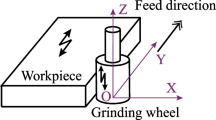Abstract
Grinding is a multipoint cutting operation, which involves random arrangement of abrasives on the tool surface. These abrasives act as cutting points with each grit particle having a unique shape and size, which makes grinding a highly complex process for analytical studies. No two grinding tools manufactured under same technical specifications have the same tool topographical features. Still, not much significant technical contribution has been made to analyse the effect of grinding wheel topographical features on the characteristic of the surface ground. Therefore, in order to mitigate the huge unpredictability in the grinding responses with respect to the variations in the tool topography, an attempt has been made to analyse the process mechanics in a way so as to make the grinding process deterministic for future applications. The present study aims at analysing the correlation between the tool topographical features such as grit protrusion height and intergrit spacing on the ground surface profile. The kinematic analysis of grit-workpiece interaction is carried out by accounting for the randomness in the grit protrusion heights and intergrit spacing and the effect of process parameters such as cutting velocity and feed per grit. The trajectory of each grit travel is calculated. A method is developed to identify the ‘active grits’, thereby reflecting only their trajectories in the surface profile. A comprehensive study is carried out on all the possible interactions of the grit trajectories, which ultimately generate the surface profile. The model analyses the effect of varying range of grit protrusion height, abrasive packing and grinding process parameters on the ground surface roughness. This analysis helps in the right range of selection of tool topographical features to obtain the desired surface characteristic.
Similar content being viewed by others
References
Chevalier J, Gremillard L (2009) Ceramics for medical applications: a picture for the next 20 years. J Eur Ceram Soc 29(7):1245–1255. https://doi.org/10.1016/j.jeurceramsoc.2008.08.025
Koshy P, Ives LK, Jahanmir S (1999) Simulation of diamond-ground surfaces. Int J Mach Tools Manuf 39(9):1451–1470. https://doi.org/10.1016/S0890-6955(99)00002-4
Koshy P, Jain VK, Lal GK (1993) A model for the topography of diamond grinding wheels. Wear 169(2):237–242
Inasaki I (1996) Grinding process simulation based on the wheel topography measurement. CIRP Ann Manuf Technol 45(1):347–350
Malkin S, Guo C (1998) Grinding technology: theory and applications of machining with abrasives. Industrial Press, New York
Zhou X, Xi F (2002) Modeling and predicting surface roughness of the grinding process. Int J Mach Tools Manuf 42(8):969–977. https://doi.org/10.1016/S0890-6955(02)00011-1
Hecker RL, Liang SY (2003) Predictive modeling of surface roughness in grinding. Int J Mach Tools Manuf 43(8):755–761. https://doi.org/10.1016/S0890-6955(03)00055-5
Kumar SK, Agarwal S (2015) Predictive modeling of surface roughness in grinding. Procedia CIRP 19:375–380
Chakrabarti S, Paul S (2008) Numerical modelling of surface topography in superabrasive grinding. Int J Adv Manuf Technol 39(1–2):29–38
Nguyen TA, Butler DL (2005) Simulation of precision grinding process, part 1: generation of the grinding wheel surface. Int J Mach Tools Manuf 45(11):1321–1328
Nguyen TA, Butler DL (2005) Simulation of surface grinding process, part 2: interaction of the abrasive grain with the workpiece. Int J Mach Tools Manuf 45(11):1329–1336
Feng W, Yao B, Yu X, Sun W, Cao X (2016) Simulation of grinding process for cemented carbide based on an integrated process-machine model. Int J Adv Manuf Technol 89(1–8):265–272. https://doi.org/10.1007/s00170-016-9035-0
Butler-Smith PW, Axinte DA, Daine M (2011) Ordered diamond micro-arrays for ultra-precision grinding—an evaluation in Ti–6Al–4V. Int J Mach Tools Manuf 51(1):54–66. https://doi.org/10.1016/j.ijmachtools.2010.09.006
Butler-Smith PW, Axinte DA, Daine M (2012) Solid diamond micro-grinding tools: from innovative design and fabrication to preliminary performance evaluation in Ti–6Al–4V. Int J Mach Tools Manuf 59:55–64. https://doi.org/10.1016/j.ijmachtools.2012.03.003
Pan J, Zhang X, Yan Q, Chen S (2016) Experimental study of surface performance of monocrystalline 6H-SiC substrates in plane grinding with a metal-bonded diamond wheel. Int J Adv Manuf Technol 89(1–9):619–627. https://doi.org/10.1007/s00170-016-9095-1
Liu W, Deng Z, Shang Y, Wan L (2017) Effects of grinding parameters on surface quality in silicon nitride grinding. Ceram Int 43(1):1571–1577
Deng H, Deng Z, Li S (2016) The grinding performance of a laser-dressed bronze-bonded diamond grinding wheel. Int J Adv Manuf Technol 88(5):1789–1798. https://doi.org/10.1007/s00170-016-8902-z
Zhu Y, Lu W, Sun Y, Zuo D (2016) Grinding characteristics in high-speed grinding of boron-diffusion-hardened TC21-DT titanium alloy with vitrified CBN wheel. Int J Adv Manuf Technol 89(1–9):1269–1277. https://doi.org/10.1007/s00170-016-9193-0
Koshy P, Jain VK, Lal GK (1997) Stochastic simulation approach to modelling diamond wheel topography. Int J Mach Tools Manuf 37(6):751–761. https://doi.org/10.1016/S0890-6955(96)00086-7
Nassirpour F, Wu SM (1979) Characterization and analysis of grinding wheel topography as a stochastic isotropic surface. J Eng Ind 101(79):165–170. https://doi.org/10.1115/1.3439490
Shi Z, Malkin S (2006) Wear of electroplated CBN grinding wheels. J Manuf Sci Eng 128(1):110–118. https://doi.org/10.1115/1.2122987
Sadeghi MH, Hadad MJ, Tawakoli T, Vesali A, Emami M (2010) An investigation on surface grinding of AISI 4140 hardened steel using minimum quantity lubrication-MQL technique. Int J Mater Form 3(4):241–251
Ming X, Gao Q, Yan H, Liu J, Liao C (2016) Mathematical modeling and machining parameter optimization for the surface roughness of face gear grinding. Int J Adv Manuf Technol 90(9-12):1–8. https://doi.org/10.1007/s00170-016-9576-2
Funding
The authors acknowledge the financial support by Science and Engineering Research Board (SERB), New Delhi via Grant No.: ECR/2015/000514/ES. This paper is a revised and expanded version of the paper entitled ‘Surface Roughness Prediction during Surface Grinding of Brittle Materials’ presented at the 6th International & 27th All India Manufacturing Technology, Design and Research conference (AIMTDR-2016), 16–18 December 2016 at College of Engineering Pune, Maharashtra, India.
Author information
Authors and Affiliations
Corresponding author
Rights and permissions
About this article
Cite this article
Anandita, S., Mote, R.G. & Singh, R. Surface generation via scallop overlap analysis during grinding. Int J Adv Manuf Technol 100, 1193–1206 (2019). https://doi.org/10.1007/s00170-017-1395-6
Received:
Accepted:
Published:
Issue Date:
DOI: https://doi.org/10.1007/s00170-017-1395-6



